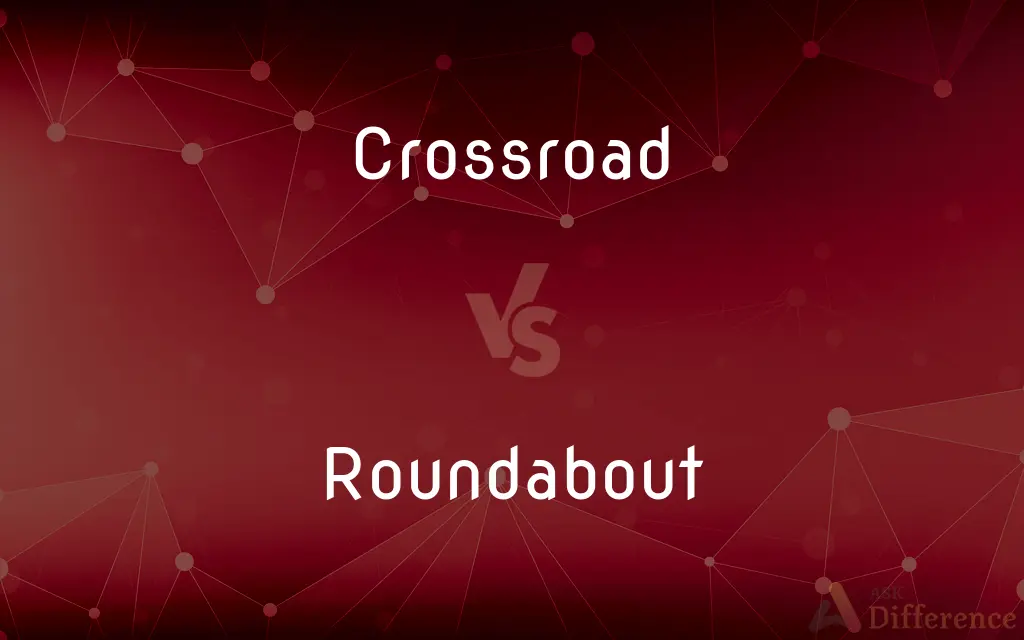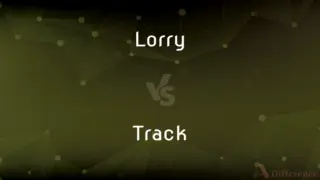Crossroad vs. Roundabout — What's the Difference?
By Fiza Rafique & Maham Liaqat — Updated on March 8, 2024
Crossroads facilitate direct intersections with stop controls, ideal for less busy areas. Roundabouts ensure continuous flow, reducing stops and collisions, suited for busier junctions.

Difference Between Crossroad and Roundabout
Table of Contents
ADVERTISEMENT
Key Differences
Crossroads are traditional intersections where two or more roads meet and typically involve stop signs, traffic lights, or uncontrolled layouts to manage the flow of traffic. They require vehicles to come to a complete stop or yield before proceeding, making them straightforward but potentially leading to higher congestion and accident rates. On the other hand, roundabouts are designed to promote a continuous flow of traffic, with vehicles entering a circular roadway and yielding to traffic already circulating. This design minimizes stop-and-go traffic, reduces the potential for high-speed collisions, and can improve fuel efficiency.
While crossroads can be more familiar and simpler to navigate for some drivers, especially in areas with lower traffic volumes, they often result in longer wait times and can increase the risk of T-bone and head-on collisions. Conversely, roundabouts, by requiring vehicles to slow down and merge into the circular pattern, significantly lower the chances of severe accidents and can handle higher volumes of traffic more efficiently.
Crossroads are generally easier and cheaper to construct and maintain than roundabouts, which require more space and a larger initial investment. However, the long-term benefits of roundabouts, including reduced congestion and lower accident severity, can make them a more cost-effective solution over time.
In regions with severe weather conditions, crossroads may pose fewer challenges to drivers unfamiliar with navigating roundabouts in snow or ice. However, roundabouts reduce the likelihood of accidents due to their lower speeds and simpler decision-making process, even in adverse weather conditions.
Crossroads often require manual traffic control during power outages or equipment failure, leading to increased congestion and delay. Roundabouts, in contrast, are self-regulating and maintain their efficiency even when traffic signals in nearby intersections may fail, providing a resilient traffic flow solution.
ADVERTISEMENT
Comparison Chart
Design
Intersecting roads with traffic controls
Circular layout for continuous flow
Traffic Flow
Stop and go, with potential for congestion
Continuous, reducing stops and delays
Safety
Higher risk of T-bone and head-on collisions
Lower collision speeds, reducing accident severity
Cost
Lower initial cost but potential for higher long-term expenses
Higher initial investment but more efficient in the long run
Weather Adaptability
Less challenging in severe weather
Requires adaptation but maintains flow
Compare with Definitions
Crossroad
Prone to specific types of accidents.
T-bone collisions are common at crossroads without adequate traffic controls.
Roundabout
Reduces the likelihood of high-speed collisions.
Roundabouts lower the chance of serious accidents compared to traditional intersections.
Crossroad
Can lead to congestion during peak hours.
The crossroad near the school becomes extremely congested in the mornings.
Roundabout
Can be landscaped for aesthetic appeal.
The roundabout's central island features a beautiful garden.
Crossroad
Often controlled by traffic signals or signs.
At the crossroad, the traffic light turned red, prompting all cars to stop.
Roundabout
Designed to improve traffic flow and safety.
Entering the roundabout, drivers yield to those already circulating.
Crossroad
Simple design but requires effective management.
The city plans to add more traffic lights to improve safety at major crossroads.
Roundabout
Requires more space than traditional intersections.
The city had to acquire additional land to construct the roundabout.
Crossroad
A junction where two or more roads cross each other.
The accident occurred at a busy crossroad downtown.
Roundabout
A circular intersection where traffic moves around a central island.
The new roundabout has significantly reduced traffic jams in the area.
Crossroad
A road that intersects another road.
Roundabout
A roundabout is a type of round (about) intersection or junction in which road traffic is permitted to flow in one direction around a central island, and priority is typically given to traffic already in the junction.Engineers use the term modern roundabout to refer to junctions installed after 1960 that incorporate various design rules to increase safety. Both modern and non-modern roundabouts, however, may bear street names or be identified colloquially by local names such as circle, road circle, traffic circle, rotary, rotunda or island.
Crossroad
A place where two or more roads meet.
Roundabout
A road junction at which traffic moves in one direction round a central island to reach one of the roads converging on it.
Turn right at the next roundabout
Crossroad
A small, usually rural community situated at an intersection of two or more roads
Asked for directions at a remote crossroads.
Roundabout
A large revolving device in a playground, for children to ride on.
Crossroad
A place that is centrally located
"Even after the effective end of the French empire in Africa by 1960, Paris remained a crossroads for African students and diplomats" (Tyler Stovall).
Roundabout
Not following a short direct route; circuitous
We need to take a roundabout route to throw off any pursuit
Crossroad
A crucial point
"At midlife, couples are at a crossroads of change, just as individuals are" (Judith Wallerstein).
Roundabout
Indirect; circuitous
Took a roundabout route because the bridge was closed.
Crossroad
A crossroads place where one road crosses another.
Roundabout
Characterized by indirectness, evasiveness, or vagueness
A roundabout claim that avoided the issues being discussed.
Crossroad
A road that crosses another.
Roundabout
A short, close-fitting jacket.
Crossroad
A road that crosses another; an obscure road intersecting or avoiding the main road.
Roundabout
A merry-go-round.
Crossroad
A junction where one street or road crosses another
Roundabout
A traffic circle.
Roundabout
Indirect, circuitous, or circumlocutionary.
Roundabout
Encircling; enveloping; comprehensive.
Roundabout
A road junction at which traffic streams circularly around a central island.
Roundabout
A horizontal wheel which rotates around a central axis when pushed and on which children ride, often found in parks as a children's play apparatus.
Roundabout
A fairground carousel.
Roundabout
A detour.
Roundabout
A short, close-fitting coat or jacket worn by men or boys, especially in the 19th century.
Roundabout
(archaic) A round dance.
Roundabout
To play on a roundabout (carousel)
Roundabout
To travel round roundabouts
Roundabout
To talk in a roundabout, indirect manner
Roundabout
Circuitous; going round; indirect; as, roundabout speech.
We have taken a terrible roundabout road.
Roundabout
Encircling; enveloping; comprehensive.
Roundabout
A large horizontal wheel or frame, commonly with wooden horses, etc., on which children ride; a merry-go-round; a carousel.
Roundabout
A dance performed in a circle.
Roundabout
A short, close jacket worn by boys, sailors, etc.
Roundabout
A state or scene of constant change, or of recurring labor and vicissitude.
Roundabout
A traffic circle.
Roundabout
A road junction at which traffic streams circularly around a central island;
The accident blocked all traffic at the rotary
Roundabout
Large mechanical apparatus with seats for children to ride on
Roundabout
Marked by obliqueness or indirection in speech or conduct;
The explanation was circuitous and puzzling
A roundabout paragraph
Hear in a roundabout way that her ex-husband was marrying her best friend
Roundabout
Deviating from a straight course;
A scenic but devious route
A long and circuitous journey by train and boat
A roundabout route avoided rush-hour traffic
Common Curiosities
Are roundabouts safer than crossroads?
Yes, roundabouts are generally considered safer than crossroads due to lower speeds and reduced conflict points.
Can roundabouts handle heavy traffic?
Roundabouts can efficiently handle high volumes of traffic by reducing stops and promoting a steady flow.
Why are crossroads still used if roundabouts are better?
Crossroads are simpler to design and cheaper to implement, making them suitable for areas with lower traffic volumes or limited space.
Can roundabouts be used in urban areas?
Yes, roundabouts can be effectively used in urban areas to manage traffic flow and enhance safety.
How do drivers navigate a roundabout?
Drivers enter a roundabout by yielding to traffic already circulating, then exit at their desired road.
What are the main benefits of roundabouts?
The main benefits of roundabouts include improved safety, reduced congestion, and lower pollution levels.
How does a roundabout work?
A roundabout is a circular intersection where drivers yield to traffic already in the circle, promoting a continuous flow of movement.
Do roundabouts require more space than crossroads?
Yes, roundabouts require more space to accommodate the circular layout and entry/exit lanes.
How do weather conditions affect roundabouts and crossroads?
Severe weather can make navigation more challenging at both types of intersections, but roundabouts maintain a more consistent flow.
What is a crossroad?
A crossroad is an intersection where two or more roads meet, often controlled by traffic signals or stop signs.
Are there different types of roundabouts?
Yes, there are various types of roundabouts, including single-lane, multi-lane, and mini roundabouts, each designed for specific traffic conditions.
Are roundabouts more environmentally friendly?
Yes, roundabouts can be more environmentally friendly due to reduced idling and smoother traffic flow, leading to lower emissions.
What measures can improve safety at crossroads?
Implementing traffic signals, adding turn lanes, and enhancing visibility can improve safety at crossroads.
Why might some drivers prefer crossroads over roundabouts?
Some drivers might find crossroads simpler to navigate, especially if they are not familiar with roundabouts.
How do roundabouts affect pedestrian safety?
Roundabouts can enhance pedestrian safety by reducing vehicle speeds and providing designated crossing areas.
Share Your Discovery

Previous Comparison
Lorry vs. Track
Next Comparison
Irrecoverable vs. UnrecoverableAuthor Spotlight
Written by
Fiza RafiqueFiza Rafique is a skilled content writer at AskDifference.com, where she meticulously refines and enhances written pieces. Drawing from her vast editorial expertise, Fiza ensures clarity, accuracy, and precision in every article. Passionate about language, she continually seeks to elevate the quality of content for readers worldwide.
Co-written by
Maham Liaqat












































